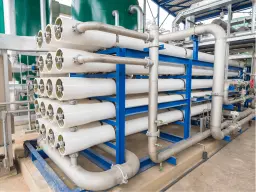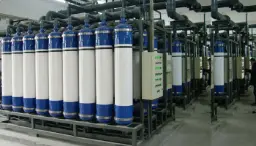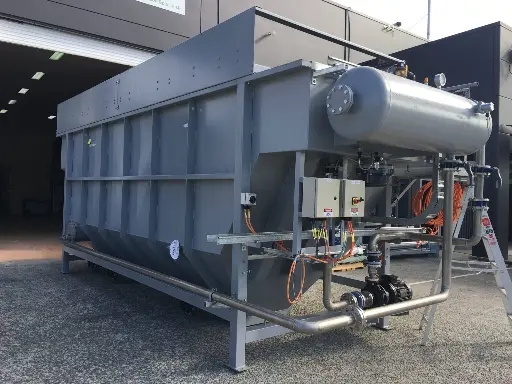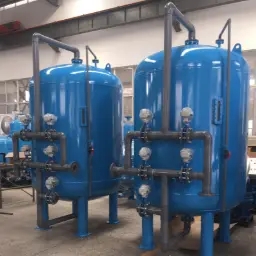Automotive Paint Shop Water Treatment
The modern automotive paint shop relies on water far beyond the simple act of washing surfaces. In body‑in‑white and pretreatment lines, large quantities of demineralised or deionised water are used to rinse phosphated panels, to neutralise alkaline cleaners, and to prepare surfaces for electrodeposition. The term paint shop water treatment describes the combination of physical, chemical, and biological unit operations applied to this rinse water stream to remove suspended paint solids, organic solvents, oils, trace metals, and microorganisms before the water is reused or discharged. Although there are many types of paint booths, the underlying principle is similar – a curtain or flood of water captures overspray and transfers it to a recirculation tank. This recirculated water gradually accumulates paint sludge, solvents, surfactants and dissolved ions. Without treatment, these contaminants would foul pumps and nozzles, degrade coating quality, and create hazardous sludge that is difficult to dewater. The treatment process restores the water to a quality suitable for recirculation within the booth or for discharge to downstream biological treatment.
A properly engineered treatment line delivers more than clean water. It protects the quality of the final paint finish by ensuring that rinse stages are free from particulate matter that could cause craters, fisheyes or other surface defects. The value of reuse is substantial in regions facing water scarcity, and automotive plants can reduce operating costs by recovering and recycling 70–90% of rinse water. However, the process also presents risks: uncontrolled pH or high conductivity can disturb the electrodeposition bath, and residual oils can destabilise chemical pretreatment. Water treatment systems intervene at these points using flocculants, clarifiers, dissolved air flotation, ultrafiltration, reverse osmosis and other technologies tailored to paint shop contaminants. In the automotive industry, integrating these systems helps maintain regulatory compliance with zero‑liquid‑discharge goals and minimises the environmental footprint of coating operations.
Related Products for Paint Shop Water Treatment
Paint shop water treatment covers a network of unit operations that handle overspray capture, sludge removal, dissolved contaminant reduction and reuse. Before detailing specific technologies, it is helpful to appreciate the challenges posed by automotive coatings. Unlike simple washing processes, paint booths generate a heterogeneous mix of materials. Water‑borne and solvent‑borne coatings shed pigments, binders and additives; pretreatment baths dissolve metal ions; and detergents contribute surfactants. The process water may also contain body shop oils and sealants that detach during spray. These constituents vary widely in particle size, density and charge, making single‑stage treatment ineffective. Engineers must design a sequence of steps that targets each contaminant class while maintaining continuous throughput, because paint lines operate on tight takt times.
Another factor driving system selection is the necessity for high rinse quality. Deionised water is often specified at the final rinse stage to prevent spotting or ionic contamination of the body. Yet the recirculated water from the booth is far from this specification. Primary treatment removes coarse paint solids through coagulation and sedimentation or flotation. Secondary stages address emulsified oils using demulsifiers and coalescers, while tertiary polishing uses membrane processes to remove dissolved salts and organics. An effective system must also dewater the resulting paint sludge to minimise disposal cost and meet waste classification regulations. Paint sludge often contains heavy metals from primer pigments and requires stabilisation before landfill. Each component of the treatment train thus plays a specific role in maintaining rinse water quality, resource efficiency and compliance with occupational safety standards.

Reverse Osmosis
To achieve high‑purity rinse water for final stages or electrodeposition, reverse osmosis is employed to remove dissolved salts, low‑molecular‑weight organics and dissolved metals. RO systems operate at high pressures through semi‑permeable membranes, rejecting ions and producing a low‑conductivity permeate. The concentrate stream is often recirculated to the UF feed or discharged to wastewater. Careful control of recovery and antiscalant dosing prevents scaling and prolongs membrane life.

Ultrafiltration
After primary clarification, ultrafiltration membranes are often used to concentrate colloidal paint particles and emulsified oils. UF removes macromolecules and suspended solids down to 0.01 µm, producing a permeate suitable for reuse in booth circulation. The retentate, rich in paint solids, can be sent to a sludge press. Membrane selection and backwashing sequences are critical to mitigate fouling from resinous paints.

Dissolved Air Flotation (DAF)
In the automotive context, DAF units inject fine air bubbles into the clarified water to float coagulated paint particles and oils to the surface for skimming. The microbubbles attach to flocs formed by coagulants and flocculants, increasing buoyancy and allowing separation of hydrophobic contaminants. A DAF is well suited for removing the heavy load of overspray solids in down‑draft booths and requires a relatively small footprint.

Sludge Dewatering Press
Mechanical presses, such as belt filter presses or filter presses, consolidate paint sludge from flotation or sedimentation processes. These units apply pressure and sometimes heat to separate water from solids, producing a cake with high solids content. Dewatering reduces disposal volume and facilitates stabilisation. Given the hazardous classification of some paint wastes, dewatering is a critical step before landfilling or incineration.
These systems collectively address the complex mixture found in paint booth recirculation water. Combining flotation for hydrophobic particles with sedimentation for denser flocs maximises solids removal efficiency. Ultrafiltration and reverse osmosis further polish the water, enabling high levels of reuse and protecting sensitive coating stages from ionic contamination.
The importance of these systems cannot be overstated for automotive plants. Without effective solids separation, paint sludge would quickly clog pumps and spray nozzles, forcing costly downtime. Coagulation and flotation systems ensure that overspray solids are removed before they can degrade water quality. Membrane operations supply high‑purity rinse water, a prerequisite for cathodic electrodeposition where ionic contaminants can lead to coating defects. Sludge dewatering reduces waste management costs and minimises the environmental impact of disposal. By integrating these technologies, paint shops achieve high water‑reuse rates, consistent coating quality and compliance with environmental regulations.
Key Water‑Quality Parameters Monitored
Process engineers monitor several parameters to maintain stable operation and prevent defects in coated bodies. pH is a primary control point because the stability of coagulation chemicals and the solubility of metal ions depend on it. In water‑borne paint systems, operators keep pH between 7.5 and 8.5 to ensure resin dispersion and proper detackification of overspray. Solvent‑borne systems can tolerate slightly higher pH, but exceeding 9.5 may destabilise emulsions and cause gel formation. Alongside pH, total alkalinity provides a buffer to resist rapid pH swings. In water‑borne booths, alkalinity of 200–350 mg CaCO₃/L is typical; insufficient alkalinity leads to erratic pH, while excessive levels can cause scale formation on recirculation equipment. Conductivity is another key indicator, reflecting dissolved solids concentration. High conductivity above 8 mS/cm suggests accumulation of salts and corrosion potential in carbon steel piping; paint shops therefore perform blowdown or partial discharge when conductivity rises above typical thresholds.
Total hardness and calcium concentration influence both corrosion and scaling. Hardness levels of 50–150 mg CaCO₃/L are commonly maintained to avoid carbonate scale in spray nozzles and heat exchangers. Water with hardness below 50 mg CaCO₃/L may be aggressive to metal surfaces, increasing corrosion. In addition to these ionic parameters, solids metrics such as total suspended solids (TSS) and turbidity are monitored. TSS quantifies the mass of paint particles per litre and is typically kept below 100 mg/L at the recirculation discharge; turbidity measurements provide real‑time indication of solids load. Organic contamination is assessed via chemical oxygen demand (COD) or total organic carbon (TOC). Elevated COD indicates soluble resins or solvents escaping capture and can stress downstream biological treatment. Microbiological counts are also measured because stagnant, paint‑laden water can support bacterial growth. Weekly dip slides help ensure counts remain below 10³–10⁴ colony‑forming units per millilitre, minimising odour and slime formation.
| Parameter | Typical Range | Control Method |
| pH | 7.5–8.5 (water‑borne), 8.0–9.5 (solvent‑borne) | Buffer with alkaline additives or acids; continuous automatic dosing |
| Total Alkalinity | 200–350 mg CaCO₃/L (water‑borne), 250–500 mg CaCO₃/L (downdraft solvent‑borne) | Adjust with sodium carbonate or bicarbonate dosing; periodic titration |
| Conductivity | Less than 8 mS/cm typical; blowdown when approaching 40 mS/cm | Periodic bleed‑and‑feed; reverse osmosis for polishing |
| Total Hardness | 50–150 mg CaCO₃/L | Use ion‑exchange softening; blend with deionised water |
| Total Suspended Solids (TSS) | Less than 100 mg/L in recirculation discharge | Coagulation–flocculation followed by sedimentation or flotation |
| Chemical Oxygen Demand (COD) | 100–500 mg/L after primary treatment | Control solvent use; implement carbon adsorption or advanced oxidation |
| Microbiological Count | Less than 10³–10⁴ CFU/mL | Weekly biocide dosing and routine cleaning |
Design & Implementation Considerations
Planning a paint shop water treatment system demands careful evaluation of source water characteristics, coating chemistry and plant layout. Raw water entering the plant may come from municipal supply, groundwater or recycled process streams, each with different hardness, alkalinity and dissolved metal profiles. Pretreatment with multimedia filtration and water softening reduces sediment and scale formation before water enters the rinse stages. When selecting coagulants, engineers must consider the specific formulation of paints used. For water‑borne acrylics, cationic polymers effectively neutralise and detackify overspray, whereas solvent‑borne paints often require amphoteric or anionic polymers. The flocculant dosage must be optimised through jar testing to achieve rapid settling or flotation without excessive sludge volume. The sizing of clarifiers and flotation units is based on overspray load and booth volume; design must account for peak production rates and cleaning cycles.
Equipment material compatibility is another critical element. Paint booth systems handle alkaline and acidic solutions, solvents and suspended abrasive pigments. Tanks and piping are often constructed of stainless steel or high‑density polyethylene to resist corrosion. Pumps selected for recirculation require seals and impellers compatible with detergents and low solids concentrations. Sensors measuring pH, conductivity and turbidity should be chosen for accuracy and durability, with automatic calibration routines to maintain reliability. System integration with the plant control network allows operators to monitor water quality in real time and adjust dosing accordingly. The design should incorporate redundancy—dual pumps and bypass lines—to maintain continuous operation during maintenance.
Compliance with ISO 14001 environmental management systems and IATF 16949 quality management standards is common in automotive plants. These standards emphasise documentation, hazard analysis and continuous improvement. Implementation therefore includes the development of standard operating procedures for chemical handling, emergency response and sludge disposal. Local wastewater discharge limits also shape design decisions: plants located in regions with strict chemical oxygen demand limits may add advanced oxidation or activated carbon polishing. Zero‑liquid‑discharge requirements encourage integration of evaporators or crystallisers to concentrate reverse osmosis brine and recover solids. In addition, the design must consider the eventual expansion of production lines or introduction of new coatings. Modular, skid‑mounted units facilitate upgrades without major downtime. Proper instrumentation, such as online TOC analysers and optical particle counters, supports proactive control and minimises manual sampling.
Operation & Maintenance
Continuous operation of a paint shop water treatment system depends on disciplined monitoring and preventive maintenance. Operators perform daily checks of pumps, mixers and instrumentation, verifying that flow rates and pressures match design values. pH and conductivity transmitters are calibrated regularly to ensure dosing systems respond correctly. Chemical feed pumps must be inspected for leaks and calibrated to deliver consistent coagulant dosage. Sludge collectors in clarifiers are cleaned on a weekly basis to prevent build‑up that could impair solids removal. Floated solids on the DAF surface should be skimmed continuously, and skimmer mechanisms require lubrication at monthly intervals.
Membrane systems such as ultrafiltration and reverse osmosis require particular attention. Feed filters are changed when differential pressure exceeds manufacturer specifications, typically around 0.2 bar for ultrafiltration systems. Backwash sequences are programmed to occur every 30 minutes during normal operation to maintain flux. Chemical cleaning‑in‑place is scheduled based on permeability decline; for example, membranes may undergo alkaline cleaning at 0.5% NaOH solution every two weeks and acidic cleaning at 2% citric acid every three months to remove scaling. Operators monitor recoveries and adjust antiscalant dosage; a drop below 75% recovery signals that membranes may require inspection. Storage tanks used for chemical dosing should be inspected for leaks and corrosion every quarter and secondary containment verified.
Booth maintenance itself influences water quality. Spray nozzles are inspected daily for clogging, and filters capturing overspray are changed according to manufacturer guidance—often every three weeks. The water reservoir in wet booths is purged weekly to remove accumulated sludge and to replenish water wash compounds. During purging, nozzles, baffles and headers are flushed to prevent sludge deposits, and any clogged nozzles are cleaned manually. Operators adjust water level controls and ensure float switches operate correctly. Biocide dosing occurs on a weekly schedule to prevent bacterial slime formation; dosage is based on microbiological counts. Safety protocols mandate the use of personal protective equipment when handling coagulants, biocides and sludge. A thorough record of maintenance activities supports compliance with quality management standards and facilitates troubleshooting.
Challenges & Solutions
Paint shop water treatment presents multiple operational challenges that require thoughtful solutions. Problem: Paint overspray forms sticky sludge that can coat internal surfaces of tanks and pipes. Solution: Early‑stage chemical detackification converts tacky paint droplets into hydrophobic flocs that either settle or float, preventing adhesion and reducing downtime during cleaning. Problem: Solvent‑borne paint overspray can emulsify with water, producing a stable emulsion that resists separation. Solution: Using amphoteric demulsifiers in conjunction with coagulants breaks these emulsions; operators fine‑tune dosage via jar testing and monitor phase separation time. Problem: High dissolved solids and conductivity accumulate in recirculation loops, risking corrosion and fouling of electrodeposition baths. Solution: Implement periodic blowdown and integrate reverse osmosis to polish the recirculated water, combined with antiscalant dosing to maintain membrane performance.
Another common issue arises from microbiological growth. Problem: Warm, nutrient‑rich booth water can support bacteria, leading to unpleasant odours and potential health hazards. Solution: Routine biocide dosing and regular cleaning of stagnant areas, coupled with maintaining pH within target ranges, suppress microbial populations. Problem: Membrane fouling due to paint resins and oils decreases permeate flux and increases energy consumption. Solution: Adequate pretreatment—efficient coagulation, flotation and fine filtration—reduces fouling loads; periodic chemical cleaning and flux monitoring help maintain performance. Problem: Disposal of paint sludge is costly and may be classified as hazardous. Solution: Dewatering presses produce cakes with higher solids content, reducing volume; adding stabilising agents immobilises heavy metals, enabling compliance with disposal regulations. Continuous improvement and training help operators anticipate and mitigate these challenges.
Advantages & Disadvantages
Water treatment in the automotive paint shop yields significant benefits but also introduces complexity. On the positive side, recycling treated water reduces consumption of potable water and discharge volumes, contributing to sustainable manufacturing. High‑quality treated water ensures consistent coating properties by eliminating foreign particles that could cause defects, thereby reducing rework and warranty claims. Treatment systems also facilitate compliance with environmental regulations by removing pollutants before discharge and enabling zero‑liquid‑discharge strategies. Economic advantages include lower freshwater purchase costs, reduced wastewater fees and decreased maintenance on downstream equipment due to cleaner circulation. Incorporating advanced monitoring and control can improve process stability and support certification under quality management standards.
There are, however, drawbacks to consider. The capital cost of equipment—clarifiers, dissolved air flotation units, membranes and control systems—can be significant, particularly when designing for redundancy. Operation requires skilled personnel to monitor water quality, adjust chemical dosing and maintain mechanical components. Energy consumption of pumps and membrane systems adds to operating costs, and chemical consumption contributes to environmental footprint if not carefully managed. Membrane concentrate and paint sludge must be handled and disposed of properly, which can be costly and subject to regulatory scrutiny. Finally, improper design or maintenance can lead to process interruptions, affecting production schedules. Understanding these trade‑offs is essential when planning and operating paint shop water treatment.
| Aspect | Advantages | Disadvantages |
| Water Consumption | Reduces freshwater use through recycling, lowering utility costs and easing pressure on local resources | Initial system cost and need for continuous monitoring add complexity |
| Coating Quality | Provides consistent rinse water quality, reducing defects such as craters or fisheyes | Over‑treatment or mis‑adjusted pH can destabilise paints and lead to defects |
| Environmental Compliance | Helps meet strict discharge limits and supports zero‑liquid‑discharge initiatives | Generates concentrated waste streams and sludge requiring proper disposal |
| Operational Reliability | Minimises pump and nozzle fouling, leading to fewer stoppages and longer equipment life | Requires skilled operators and regular maintenance to maintain reliability |
| Economic Impact | Lowers long‑term costs through water reuse and reduced waste management fees | Capital investment and ongoing chemical and energy expenses can be high |
Frequently Asked Questions
Paint shop water treatment raises many questions among engineers and plant managers. One recurring question concerns how often water should be replaced. In modern systems, complete replacement of recirculation water is rare; instead, partial blowdowns are performed when conductivity approaches upper limits or when chemical oxygen demand levels rise despite treatment. Blowdown volumes are calculated based on mass balance and production rate. Another question relates to the suitability of using ordinary tap water for final rinsing. While municipal water may meet drinking standards, its hardness and dissolved solids can leave residues on freshly painted surfaces; therefore, deionised or reverse‑osmosis‑treated water is typically used in final rinses. Plant managers also inquire about the best coagulant for overspray removal. The answer depends on paint chemistry: cationic polymers work well for water‑borne systems, whereas solvent‑borne coatings may require specialised amphoteric formulations.
Questions about sludge handling are common. Operators want to know if sludge can be dewatered on‑site and disposed of as non‑hazardous waste. The classification of paint sludge depends on its composition, particularly the presence of heavy metals such as chromium or zinc from primers. Dewatering presses reduce water content, but stabilising agents may be needed to render the sludge non‑leaching according to local regulations. Many engineers also ask how often membranes should be cleaned. The frequency is dictated by permeability decline; monitoring flux and performing cleaning when permeability drops by 10–15% is a common approach. Another frequently asked question involves the cost of operating these systems. Operational costs include chemicals, energy and maintenance labour; however, they are typically offset by savings in water purchase and waste disposal. Finally, concerns about system integration arise: how to tie water quality monitoring into existing plant controls. Modern treatment systems are delivered with programmable logic controllers and communication protocols to interface with supervisory control and data acquisition systems, enabling real‑time alarms and trending. By addressing these questions, paint shop operators can better understand and optimise their water treatment practices.